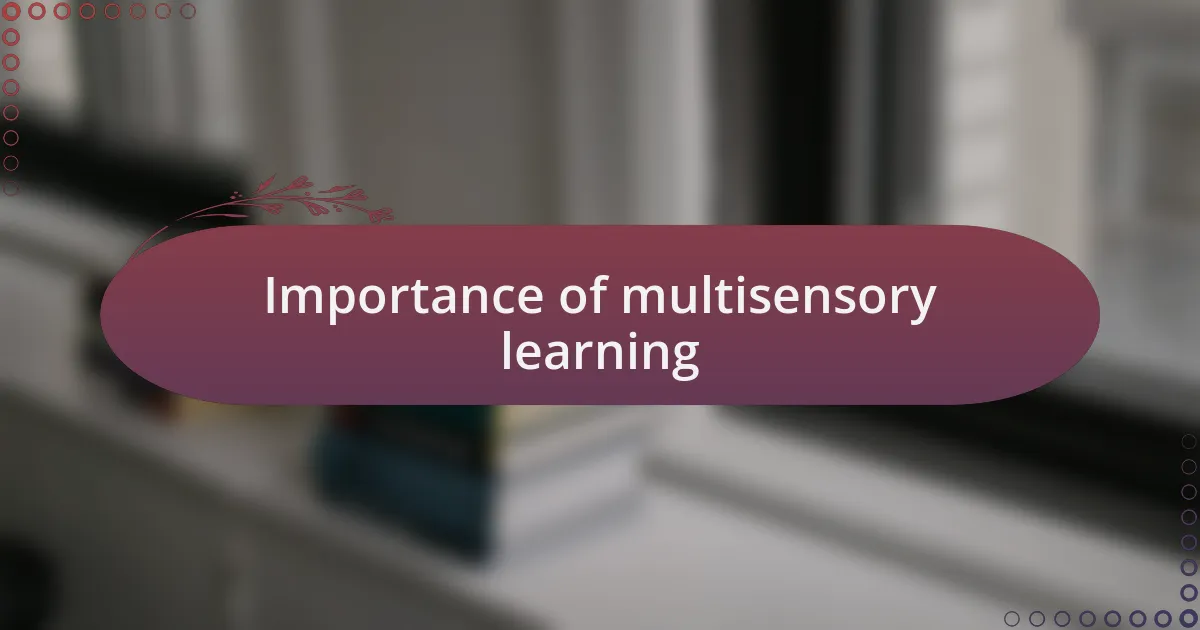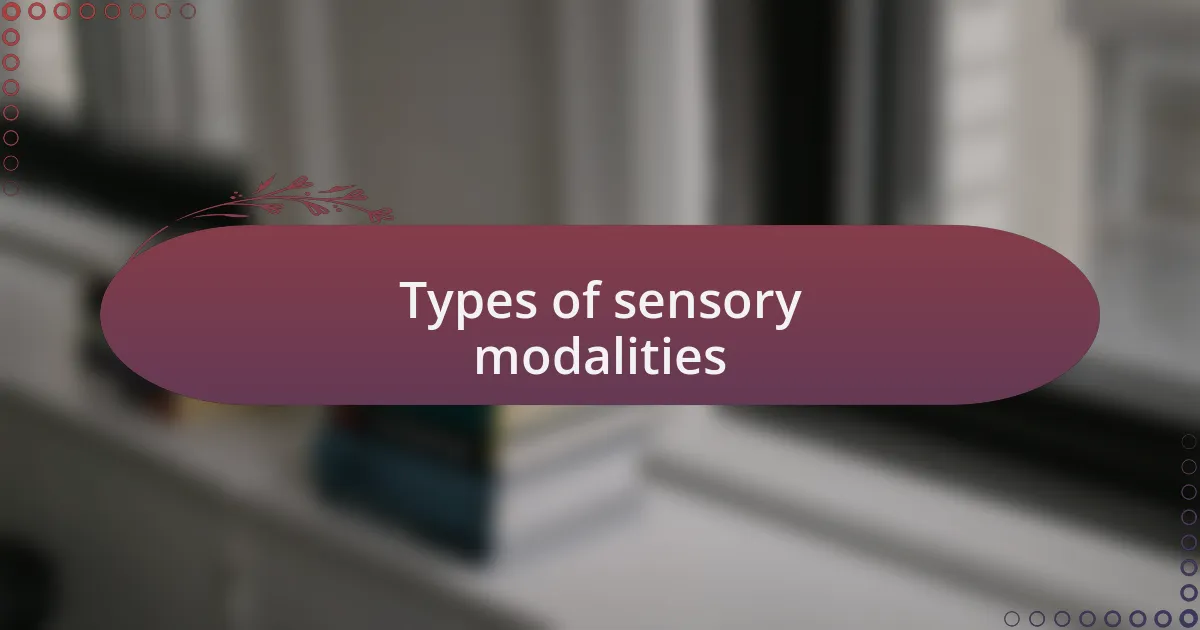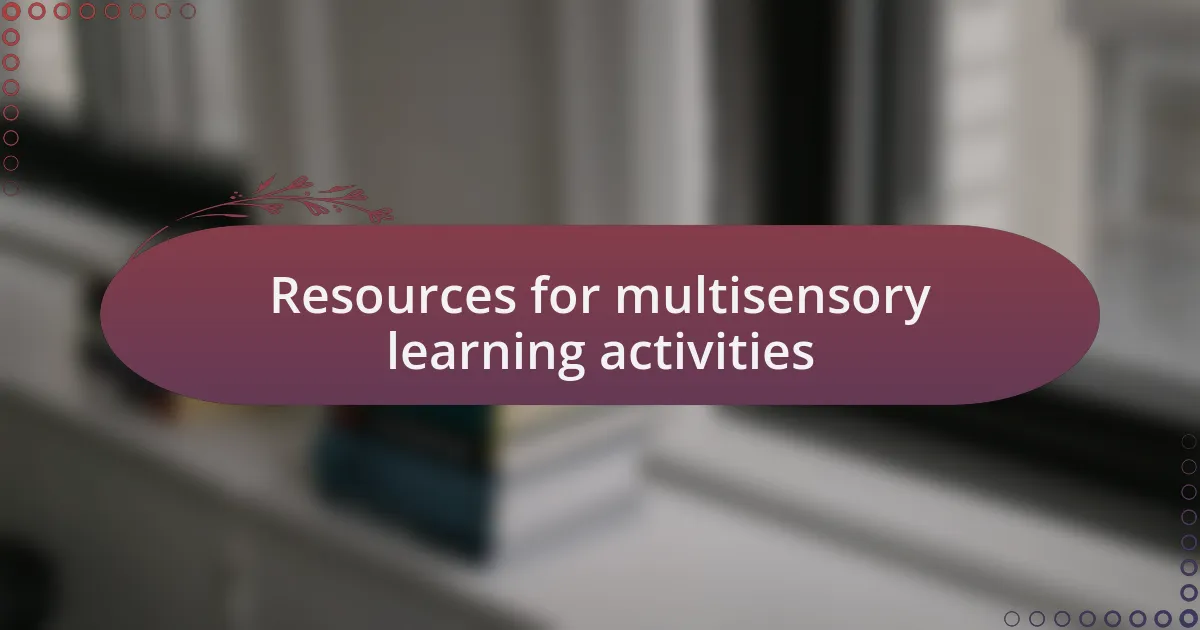Key takeaways:
- Multisensory learning combines various senses—sight, sound, touch, taste, and movement—to enhance understanding and retention, catering to diverse learning styles.
- This approach is especially beneficial for individuals with learning differences, emphasizing the importance of engaging various sensory modalities for effective learning experiences.
- Using hands-on activities and integrating technology can create immersive educational experiences, making abstract concepts more concrete and memorable.
- Resources like manipulatives and sensory bins enrich learning, fostering curiosity and engagement through tactile interactions.

Understanding multisensory learning
Multisensory learning engages more than just the auditory or visual senses; it encourages a combination of sight, sound, touch, taste, and movement to facilitate deeper understanding. I remember when I first witnessed a multisensory approach in action during a workshop for young learners. Seeing students connecting letters to sounds while physically manipulating colorful shapes created an immersive experience that lit up their faces with excitement and understanding.
When we think about how we absorb information, it’s clear that our brains are wired to make connections through various pathways. Don’t you sometimes find that you remember something better after experiencing it firsthand? This is precisely the beauty of multisensory learning—it taps into different memory systems, making the learning experience richer and more memorable. For example, combining storytelling with hands-on activities not only captivates attention but also helps solidify concepts in a way that’s often more profound than traditional methods.
Furthermore, multisensory learning can particularly benefit individuals with learning differences, who may struggle with standard teaching approaches. I once worked with a student who found traditional reading challenging. By integrating movement and tactile materials—like using clay to form letters—this student not only improved their literacy skills but also gained confidence in their abilities. Isn’t it rewarding to see how addressing various sensory needs can open doors for different learners?

Importance of multisensory learning
Engaging multiple senses during the learning process is crucial because it caters to the diverse ways people process information. I remember a time when I introduced a science topic using a blend of visuals, manipulatives, and activities. The students not only grasped the concepts faster but their enthusiasm was infectious—it was amazing to watch them eagerly discuss what they had learned, illustrating how multisensory experiences can transform a lesson from mundane to memorable.
One of the key benefits of multisensory learning is its ability to enhance retention. I’ve had students tell me that they can still recall lessons where they physically engaged with material, like when we used music and movement to learn math facts. Isn’t it fascinating how combining rhythm and action allows information to stick? This multisensory approach not only aids memory but fosters a deeper connection to the subject matter, making learners more invested in their education.
Moreover, multisensory learning is a game-changer for those who struggle with conventional methods. I’ll never forget the moment a shy student, who often felt out of place in a traditional classroom, flourished when we incorporated art and movement into our lessons. Watching that transformation reminded me that providing varied learning experiences can lead to breakthroughs for all learners. How empowering it is to see students thrive when we embrace their unique learning styles!

Types of sensory modalities
When we talk about sensory modalities, we typically refer to the primary ways our senses engage with the world: visual, auditory, tactile, olfactory, and gustatory. Visual learners often thrive on images and diagrams, while auditory learners benefit from lectures and discussions. One time, I had a group project where students created presentations; it was fascinating to see how visuals like charts and videos captivated the visual learners, while the auditory learners brought the concepts to life through engaging narratives.
Then there are tactile learners, who need that hands-on experience to truly understand a concept. I once conducted a science experiment where students had to build a model of a solar system. Watching their hands get messy with clay as they shaped planets sparked genuine excitement and deeper understanding. This made me realize that when we allow students to manipulate materials, we not only engage their senses but also enhance their comprehension.
I can’t overlook the impact of olfactory and gustatory modalities, even if they often take a backseat in educational settings. I remember integrating a cooking lesson into our history unit, where we made traditional dishes from different cultures. The smells and tastes transported us to those places and times, making history come alive in a way that textbooks seldom do. This experience highlighted for me that even elusive senses can play a vital role in creating memorable learning experiences.

Advantages of multisensory approaches
The advantages of multisensory approaches in education are incredibly impactful. I vividly recall a time when I transformed a dull vocabulary lesson into a lively word game involving physical movement, sounds, and even gestures. Not only did students become more engaged, but they also retained the words better. It made me wonder: Why stick to one sensory method when our brains respond so well to the richness of multiple inputs?
Another advantage is that these methods cater to diverse learning styles. I had a student who struggled with reading comprehension but excelled in art. One day, we combined storytelling with drawing, allowing him to illustrate key story elements. The change in his understanding was remarkable, proving that when we tap into different senses, we unlock pathways for all learners to excel.
Moreover, multisensory learning can significantly enhance emotional connections to the material. During a lesson on environmental science, we went outside, touched the bark of trees, listened to birds, and even planted seeds. It struck me then how these experiences fostered not just knowledge but also a genuine appreciation for nature. I found myself reflecting on how essential it is to create strong emotional ties in learning; it’s these connections that often lead to long-lasting understanding.

Tips for implementing multisensory learning
When implementing multisensory learning, I suggest starting simple. For instance, incorporate physical activities related to the lesson objectives. One time, I had my students physically arrange themselves to illustrate the concept of place value in math. Watching them enthusiastically move and interact helped solidify their understanding in a way that simply explaining the concept never could.
Consider using sensory materials that engage touch, smell, and sound. I once introduced a science lesson on the senses using various spices. The students not only smelled and touched them but also created a chart documenting their experiences. This hands-on approach led to animated discussions that made the topic memorable. Isn’t it fascinating how engaging multiple senses can transform abstract concepts into concrete experiences?
Finally, don’t shy away from incorporating technology that enhances multisensory experiences. I recall integrating virtual reality into a history lesson, such as a tour through ancient Rome. Students were captivated, feeling like they were truly stepping into another world. How can we harness technology in our classrooms to elevate learning to new heights? Exploring these avenues can lead to an educational environment buzzing with curiosity and understanding.

Resources for multisensory learning activities
When it comes to resources for multisensory learning activities, I find that hands-on manipulatives are incredibly effective. I remember using a collection of geometric shapes during a lesson on angles and measurements. Allowing students to physically hold, rotate, and combine shapes not only made the concepts clearer but also sparked spontaneous discussions among them. Have you ever noticed how much more engaged students become when they can physically interact with the material?
Another resource that I absolutely recommend is sensory bins. In one memorable social studies lesson, I created a sensory bin filled with sand, small figures, and artifacts related to ancient cultures. As students sifted through the materials, they were thrilled to make discoveries that related directly to our studies. This tactile approach ignited their curiosity, proving that learning can be a delightful adventure when multiple senses are involved.
Don’t forget about digital resources, either. I once facilitated a writing project where students used audio recording apps to narrate their stories. This not only allowed them to express themselves creatively but also helped develop their listening skills as they critiqued each other’s work. Isn’t it amazing how technology can transform a simple writing task into a rich, multisensory experience?